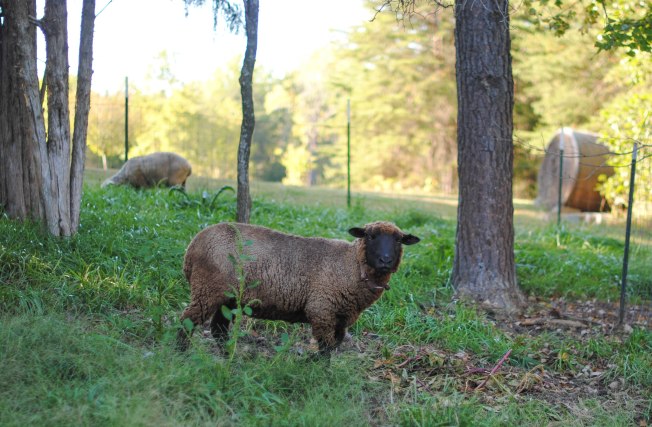
Ready for another foray into cables and lace and color? The Escondido Falls Shawl is a wedge-shaped shawl worked from the bottom up, with a lush lace and densely cabled edging.
You can work it in either two colors as shown above, in one color as shown at the end of the post, or (not shown) in one color for the body and cable section, and a second color for the lace.
I got to meet Gerty, Anzula’s new 100% Targhee yarn, this summer at TNNA. I decided to do a two-colored cable shawl to explore how Gerty would play with the cables, lace, and colorwork. I chose Clay, a greenish neutral, as the CC, and Teddy, a warm rich brown.
After lots of swatching, and playing with different options (fair isle in the center of the cable, different widths to the linen stitch edging, etc), I ended up with the pattern as is. My sample knitter Cambria finished the sample for me.
With the deadline looming, I thought it’s be great to do a single colored version as well, for those of you who just want to play with TWO techniques (cables and lace) at a time.  A quick email to my sample knitter Annette verified she could do the sample, and a quick email to Anzula ensured there were three skeins of the same dyelot available. I think it looks gorgeous in the blue as well!
A quick email to my sample knitter Annette verified she could do the sample, and a quick email to Anzula ensured there were three skeins of the same dyelot available. I think it looks gorgeous in the blue as well!
The Targhee is extremely bouncy. You can block the heck out of it and it springs back. I initially blocked the two-colored cable shawl to 90¼” / 229 cm along the lace edge to really open up the lace; it now measures 77¼” / 196.5cm, two weeks or so later (the lace edge looks great still!). Note that the gauge for the textured section is a bit tighter, which gives the shawl of bit of a curled shape.

This shawl gets a California place name! I love exploring California parks, and especially waterfall hikes. There are some really neat waterfalls in the Los Angeles area, especially if we’ve had a wet winter.
One of the best is Escondido Falls in Malibu. We brought our dog Rigel with us when we did this hike back in 2009. It was quite the adventure for both us and him! You can read about the hike here.
Shawl details:
One size, easily altered
Finished Measurements
Length along lace edge: 77¼” / 196.5cm
Width at top: 27” / 68.5 cm
Yarn
Anzula Gerty, 100% American Targhee (390 yds / 357 m per 4.02 oz / 114g), 2 skeins Teddy (MC), 1 skein Clay (CC) (or) 3 skeins Blueberry
1040 yds / 951 m total, approx 730 yds / 668 m MC and 310 yds / 283 m CC
Needles
US4 / 3.5mm circular needles or size to obtain gauge
Gauge
25 sts and 32 rows = 4” / 10 cm in Dot Knit textured pattern, blocked
Cable Section Width: 2” / 5 cm, blocked
Lace Edging Width at widest point: 4” / 10 cm, blocked
Lace Edging Height: 4” / 10 cm, blocked
Notions
cable needle, yarn needle
Skills
For two-colored version: stranded knitting, following colorwork charts
All versions: Cabling, lace
Line by line directions given for single color only


 This lovely light fingering weight shawl, worked as a wedge , incorporates an Aran lace and geometric side edging, with a lacy textured body. The versatile shape can be worn a variety of ways!
This lovely light fingering weight shawl, worked as a wedge , incorporates an Aran lace and geometric side edging, with a lacy textured body. The versatile shape can be worn a variety of ways!













 A quick email to my sample knitter Annette verified she could do the sample, and a quick email to Anzula ensured there were three skeins of the same dyelot available. I think it looks gorgeous in the blue as well!
A quick email to my sample knitter Annette verified she could do the sample, and a quick email to Anzula ensured there were three skeins of the same dyelot available. I think it looks gorgeous in the blue as well!






 The Dry Creek Sweater is named after my favorite AVA ((American Viticultural Area) in Sonoma County, the Dry Creek Valley. This was the first name I came up with for a pattern in the Winery Knits Collection — that’s how much I love the area!
The Dry Creek Sweater is named after my favorite AVA ((American Viticultural Area) in Sonoma County, the Dry Creek Valley. This was the first name I came up with for a pattern in the Winery Knits Collection — that’s how much I love the area!

 The
The 
 Are you interested in teaching crafts? Pick up a copy of
Are you interested in teaching crafts? Pick up a copy of